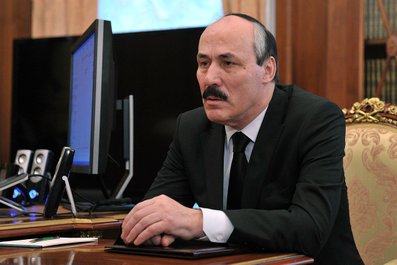
Dagestan Is Enmeshed in Another Round of Ethnic Confrontation
Publication: Eurasia Daily Monitor Volume: 10 Issue: 39
By:

Following the Kumyks, who held a rally in the city of Pyatigorsk on February 10 (https://www.chernovik.net/content/lenta-novostey/v-pyatigorske-proshyol-sezd-kumykskogo-naroda), Chechen residents of Dagestan have also come out into the streets to protest. The organizers of a rally held on February 23 to mark the 69th anniversary of the Chechen nation’s deportation to Kazakhstan and Central Asia decided to turn it into a permanent protest (https://kavkazcenter.com/russ/content/2013/02/25/96434.shtml). Dagestan’s Chechens are demanding that the Dagestani government resettle them in the towns where they lived before the deportation. Chechens who have returned from exile have not been able to return to their own settlements for more than a half-century. After the Chechens were deported in February 1944, Dagestani Laks and Avars were resettled in their homes. The issue of the return of Chechen land and property has thus been a major issue in this part Dagestan for a long time.
Approximately 100,000 Chechens reside in Dagestan—3.22 percent of the republic’s population (www.gks.ru/free_doc/new_site/perepis2010/croc/results2.html). However, the proximity of the 1.5 million Chechens in neighboring Chechnya certainly adds weight to the Dagestani Chechens’ claims. Chechnya closely watches the situation in Dagestan. So far, the Dagestani Chechens have made no political demands. Concentrated along the Aktash and Yaryk-Su rivers, the Chechens were involuntarily included in Dagestan in 1921, despite their wish to be included in the Chechen autonomous republic that existed at the time (Ed. Y.A. Aidaev, Chechens: History and Modernity, Moscow, 1996, pp. 196–198). The Chechens in Dagestan today reside in the Khasavyurt, Babayurt, Novolak and Kazbek districts in the northern part of the republic.
At some point after the demise of the Soviet Union, the Dagestani government heeded the constant demands of the Chechens and called on the Laks and Avars to relocate to the area near Makhachkala, thereby freeing up the area that belonged to the Chechen people. The Avar and Lak settlers were supposed to receive land and new homes from the government. A special republican program was created for the socio-economic development of the newly-founded settlements (Dagestani government decree, March 31, 2003, https://auh-inform.ru/index.php?name=News&op=article&sid=60). However, the resettlement of the Laks has taken years and made the Chechens impatient. There are fewer and fewer Chechens left who were sent into exile in 1944 and were unable to return to their homes—a fact that exasperates the Chechen side. One of the best known Dagestani Chechens, three-time Olympic wrestling champion Buvaisar Saitiev, said in a recent interview that Chechens are embittered by the absence of progress on this issue (https://kavpolit.com/za-dagestan-bolno-no-byt-chinovnikom-ne-xochu/).
Several inter-ethnic conflicts already brew in the area to which the Chechens lay territorial claims—Chechen-Kumyk, Chechen-Lak, Chechen-Avar and Chechen-Cossack. Another spinoff from this conflict includes the tensions between Avars and Kumyks. Any serious disagreement on an individual level between members of different ethnic groups quickly turns into a larger-scale ethnic confrontation in this area (https://sitkin.narod.ru/etno.htm), which makes the region especially unpredictable and explosive. It is no wonder that this part of Dagestan is also one of the most deadly in terms of insurgency-related violence. The notion adopted by the armed resistance about Muslims having no nationality and therefore no reason to fight over land finds support among some young people. However, the authorities’ countervailing concept of peaceful coexistence of all people is not working in Dagestan, ethnically the most heterogeneous republic of the North Caucasus.
The new government of Dagestan, led by the republic’s acting president Ramazan Abdulatipov, is unlikely to be willing to become mired in this tangle of ethnic conflicts. Still, the Chechen protesters formed a special delegation to go to Makhachkala to deliver their message. Things could possibly have been resolved peacefully had the district authorities not ignored the protest and called in special police units. Even though the police did not try to disperse the aforementioned February 23 gathering, the authorities’ apparent intention to intimidate the protesters offended the rally’s young participants, who resolved to make their strike permanent. Rumors spread that the former president of Dagestan, Magomedsalam Magomedov, told a small circle of his associates that the promises to restore Chechens’ land would be postponed for another two years (www.kavkaz-uzel.ru/articles/220642/). The authorities eventually managed to talk the demonstrators into suspending their protest and asked them for a two-month period in which to respond to their demands (www.kavkaz-uzel.ru/articles/220694/?utm_source=dlvr.it&utm_medium=twitter). If the response is not favorable, the protesters said, they vow to stage a protest rally even larger than simply blocking a highway.
Could Abdulatipov’s hesitation to act on this issue be linked to his ignorance about the situation of the Dagestani Chechens? It is unlikely. During the period Abdulatipov was member of the Russian parliament and the minister for nationalities affairs, he was personally aware of this situation.
The Dagestani Chechen rally highlighted once again the multitude of issues that Dagestanis have faced during the past century. Officially, 14 large ethnic groups are recognized as indigenous groups in Dagestan (https://lawru.info/base89/part7/d89ru7364.htm). The Kumyks are demanding that other people stop settling on their lands and also want their historical district of Tarki to be restored near Makhachkala. The Nogais are demanding their own autonomous region. Problems also arise from the exodus of the ethnic Russians and Cossacks from northern Dagestan. The problem of divided peoples, such as the Lezgins as well as others, has not been resolved. The new president of Dagestan will have to dedicate much effort to determine his priorities—whether, for example, the government’s primary concern should be ethnic conflicts or the armed resistance.
Thus, Dagestan remains plagued by numerous problems that have never been solved. Against the background of a confrontation between ethnic clans and a Salafi armed rebellion, the addition of inter-ethnic problems could tear the republic apart. Moscow does not want a deterioration of the situation in the region that would threaten both the Olympic Games in Sochi in 2014 and the much advertised mountain and seaside resort development projects in Dagestan. Therefore, the local Dagestani authorities will likely soon be compelled to seriously address these problems, but it will undoubtedly be the federal authorities who will intervene more profoundly in the republic’s affairs.




